
The Battle of the Thames, also known as the Battle of Moraviantown, was an American victory in the War of 1812 against Tecumseh's Confederacy and their British allies. It took place on October 5, 1813, in Upper Canada, near Chatham. The British lost control of Southwestern Ontario as a result of the battle; Tecumseh was killed, and his confederacy largely fell apart.

The Battle of Lundy's Lane, also known as the Battle of Niagara, was fought on 25 July 1814, during the War of 1812, between an invading American army and a British and Canadian army near present-day Niagara Falls, Ontario. It was one of the bloodiest battles of the war, and one of the deadliest battles fought in Canada, with approximately 1,720 casualties including 258 killed.
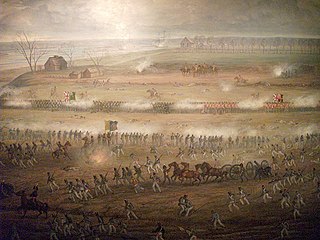
The Battle of Crysler's Farm, also known as the Battle of Crysler's Field, was fought on 11 November 1813, during the War of 1812. A British and Canadian force won a victory over a US force which greatly outnumbered them. The US defeat prompted them to abandon the St. Lawrence Campaign, their major strategic effort in the autumn of 1813.
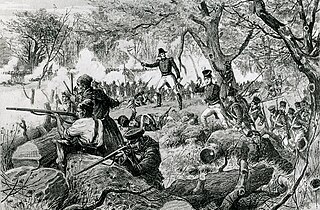
The Battle of the Chateauguay was an engagement of the War of 1812. On 26 October 1813, a combined British and Canadian force consisting of 1,530 regulars, volunteers, militia and Mohawk warriors from Lower Canada, commanded by Charles de Salaberry, repelled an American force of about 2,600 regulars which was attempting to invade Lower Canada and ultimately attack Montreal.

Brevet Brigadier-General James Miller was a senior officer of the United States Army who commanded infantry in the Canadian Theater of the War of 1812. After the war, he served as the first governor of Arkansas Territory from 1819 to 1824. He also served as the superintendent of Indian affairs for the territory. It was during his term as governor, and partly due to his influence, that the territory's capital was moved from Arkansas Post to Little Rock.

The siege of Fort Erie, also known as the Battle of Erie, from 4 August to 21 September 1814, was one of the last engagements of the War of 1812, between British and American forces. It took place during the Niagara campaign, and the Americans successfully defended Fort Erie against a British army. During the siege, the British suffered high casualties in a failed storming attempt; they also suffered casualties from sickness and exposure in their rough encampments. Unaware that the British were about to abandon the siege, the American garrison launched a sortie to destroy the British siege batteries, during which both sides again suffered high losses.
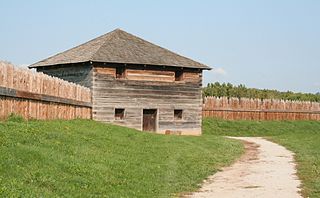
The siege of Fort Meigs took place in late April to early May 1813 during the War of 1812 in northwestern Ohio, present-day Perrysburg. A small British Army unit with support from Indians attempted to capture the recently constructed fort to forestall an American offensive against Detroit, and its Fort Detroit in the Great Lakes region which the British from the north in Canada had captured the previous year. An American sortie and relief attempt failed with heavy casualties, but the British failed to capture the fort and were forced to raise the siege.

The siege of Fort Wayne took place from September 5 – September 12, 1812, during the War of 1812. The stand-off occurred in the modern city of Fort Wayne, Indiana between the U.S. Military garrison at Fort Wayne and a combined force of Potawatomi and Miami forces. The conflict began when warriors under the Potawatomi Native American Chiefs Winamac, and Five Medals killed two members of the U.S. garrison. Over the next several days, the Potawatomi burned the buildings and crops of the fort's adjacent village, and launched assaults from outside the fort. Winamac withdrew on 12 September, ahead of reinforcements led by Major General William Henry Harrison.

The Battles of Frenchtown, also known as the Battle of the River Raisin and the River Raisin Massacre, were a series of conflicts in Michigan Territory that took place from January 18–23, 1813, during the War of 1812. It was fought between the United States of America and a joint force of British and Native Americans near the River Raisin in Frenchtown.
The Battle of the Mississinewa, also known as Mississineway, was an expedition ordered by William Henry Harrison against Miami Indian villages in response to the attacks on Fort Wayne and Fort Harrison in the Indiana Territory. The site is near the city of Marion, Indiana.

The siege of Detroit, also known as the surrender of Detroit or the Battle of Fort Detroit, was an early engagement in the War of 1812. A British force under Major General Isaac Brock with indigenous allies under Shawnee leader Tecumseh used bluff and deception to intimidate U.S. Brigadier General William Hull into surrendering the fort and town of Detroit, Michigan, along with his dispirited army which actually outnumbered the victorious British and Indians.
The Battle of Longwoods took place during the Anglo-American War of 1812. On 4 March 1814, a mounted American raiding party defeated an attempt by British regulars, volunteers from the Canadian militia and Native Americans to intercept them near Wardsville, in present-day Southwest Middlesex, Ontario.
Major-General Henry Patrick Procter was a British Army officer who served in the Canadas during the War of 1812. He is best known for being decisively defeated in 1813 by American forces, which left the western portion of Upper Canada under U.S. control. Procter is regarded by numerous commentators as an inept leader who relied heavily on textbook procedure. His "going by the book" is attributed to his lack of any combat experience before coming to Canada.

The Battle of Mackinac Island was a British victory in the War of 1812. Before the war, Fort Mackinac had been an important American trading post in the straits between Lake Michigan and Lake Huron. It was important for its influence and control over the Native American tribes in the area, which was sometimes referred to in historical documents as "Michilimackinac".
The Battle of Brownstown was an early skirmish in the War of 1812. Although the United States military outnumbered the forces of Tecumseh's Confederacy 8 to 1, they lost the battle and suffered substantial losses while Tecumseh's forces were almost untouched.
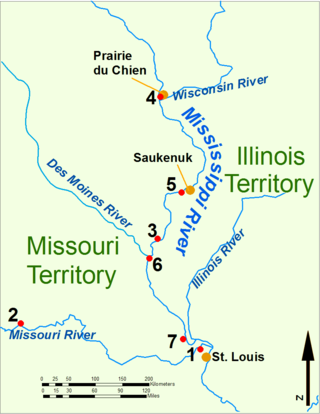
The Siege of Prairie du Chien was a British victory in the far western theater of the War of 1812. During the war, Prairie du Chien was a small frontier settlement with residents loyal to both American and British causes. By 1814, both nations were anxious to control the site because of its importance to the fur trade and its strategic location at the intersection of the Mississippi River and the Fox-Wisconsin Waterway, a transportation route linking the Mississippi with the Great Lakes.

Mongaugon Township, is a former township of Wayne County in the U.S. state of Michigan. Quarries including the DTE Energy Sibley Quarry that mines, gray limestone and celestine associated with calcite, fluorite, gypsum, epsomite, and rarely, sulfur were first worked by the French circa 1749. United States forces aided by Muskrat French defeated United Kingdom aided by Native Americans forces at the Battle of Monguagon during the War of 1812.

Campbell's Island is an island and unincorporated community in the Mississippi River. The island is located in Hampton Township, Rock Island County, Illinois. It is adjacent to the city of East Moline and is connected to the city by a bridge. It is the site of the Campbell's Island State Memorial, a listed historic site overseen by the Illinois Historic Preservation Agency.
Major Adam Charles Muir was an officer in the British Army, who played a significant but little-known role in the Anglo-American War of 1812.
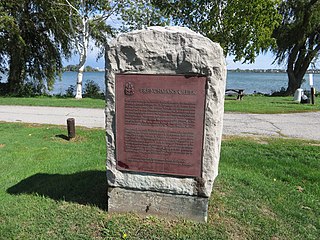
The Battle of Frenchman's Creek took place during the War of 1812 between Great Britain and the United States in the early hours of November 28, 1812, in the Crown Colony of Upper Canada, near the Niagara River. The operation was conceived as a raid to prepare the ground for a larger American invasion. The Americans succeeded in crossing the Niagara and landing at both of their points of attack. They achieved one of their two objectives before withdrawing but the invasion was subsequently called off, rendering useless what had been accomplished. The engagement was named, "the Battle of Frenchman's Creek" by the Canadians, after the location of some of the severest fighting. To contemporary Americans, it was known as, "the Affair opposite Black Rock".
















